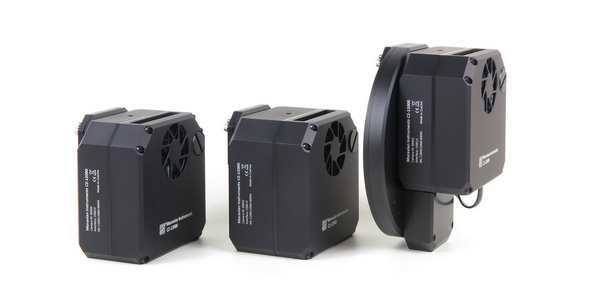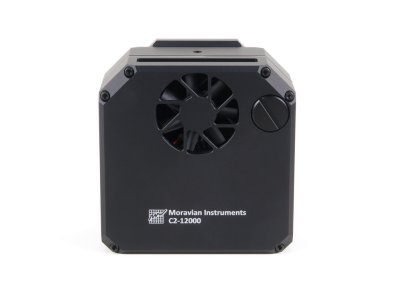Moravian Instruments C2-12000 CMOS camera with Sony IMX253 sensor
The C2 cameras are designed to work in cooperation with a host Personal Computer (PC). As opposite to digital still cameras, which are operated independently on the computer, the scientific cameras usually require computer for operation control, image download, processing and storage etc. To operate the camera, you need a computer which:
- Is compatible with a PC standard and runs modern 32 or 64-bit Windows operating system
- Is an x86 or ARM based computer and runs 32 or 64-bit Linux operating system
- Support for x64 based Apple Macintosh computers is also included.
C2 cameras are designed to be connected with the host PC through USB 3.0 interface, operating at 5 Gbps. Cameras are also compatible with USB 2.0 port to communicate with a host PC.
Alternatively, it is possible to use the Moravian Camera Ethernet Adapter device. This device can connect up to four Cx (with CMOS sensors) or Gx (with CCD sensors) cameras of any type and offers 1 Gbps and 10/100 Mbps Ethernet interface for direct connection to the host PC. Because the PC then uses TCP/IP protocol to communicate with the cameras, it is possible to insert WiFi adapter or other networking device to the communication path.
The C2 cameras need an external 12 V DC power supply to operate. The wall adapter providing proper voltage is shipped with every camera.
Note the camera must be connected to some optical system (e.g. the telescope) to capture images. The camera is capable of long exposures, necessary to acquire the light from faint objects. If you plan to use the camera with the telescope, make sure the whole telescope/mount setup is capable to track the target object smoothly during long exposures.
C2 camera head is designed to be easily used with a set of accessories to fulfill various observing needs. Camera head itself is manufactured in two different variants:
-
Camera with Internal filter wheel.
-
Camera with control port for External filter wheel. This model allows attachment of several variants of external filter wheels with various number of filter positions and sizes.

Conversion factors and read noise
Generally, many sensor characteristics depend on the used gain. Hence, we provide two lists of parameters for both minimal and maximal gain.
Camera/sensor parameters for sensors with 3.45 × 3.45 μm pixels:
| Digitization resolution |
12-bit |
12-bit |
8-bit |
8-bit |
| Sensor gain |
0 dB |
24 dB |
0 dB |
24 dB |
| Full well capacity |
11000 e-
|
1100 e-
|
2600 e-
|
1100 e-
|
| Conversion factor |
2.8 e-/ADU |
0.3 e-/ADU |
10.0 e-/ADU |
4.4 e-/ADU |
| Read noise |
2.2 e- RMS |
2.0 e- RMS |
4.2 e- RMS |
9.7 e- RMS |
Camera/sensor parameters for sensors with 4.50 × 4.50 μm pixels:
| Digitization resolution |
12-bit |
12-bit |
| Sensor gain |
0 dB |
24 dB |
| Full well capacity |
26000 e-
|
2100 e-
|
| Conversion factor |
6.3 e-/ADU |
0.5 e-/ADU |
| Read noise |
5.3 e- RMS |
3.9 e- RMS |
Camera Electronics
Controlling of the rolling shutter sensors differs significantly from controlling of the global shutter sensors and thus the camera C2-9000 internals are quite different from other C2 models.
The C2-9000 contains 256 MB of onboard memory, capable to store up to 14 full-resolution frames. Camera API allows for sequential exposures, during which short-exposure images are stored into memory possibly faster than the host computer is able to read them. Sequential exposures are paused when the internal memory is filled with images, not yet read by the host PC. As explained earlier, rolling shutter sensors are capable to perform image exposure while digitizing the previous image.
Camera Gain
Sensors used in C2 cameras offer programmable gain from 0 to 24 dB, which translates to the output signal multiplication from 1× to 15.9×. Gain can be set with 0.1 dB step.
Exposure control
C2 cameras are capable of very short exposures. The shortest exposure time is 125 μs (1/8000 of second). This is also the step, by which the exposure time is expressed. So, the second shortest exposure is 250 μs etc.
Long exposure timing is controlled by the host PC and there is no upper limit on exposure time. In reality the longest exposures are limited by saturation of the sensor either by incoming light or by dark current (see the following sub-chapter).
Mechanical shutter
C2 cameras are equipped with mechanical shutter, which is an important feature allowing unattended observations (fully robotic or just remote setups). Without mechanical shutter, it is not possible to automatically acquire dark frames, necessary for proper image calibration etc.
Mechanical shutter in the C2 cameras is designed to be as reliable as possible, number of open/close cycles is virtually unlimited, because there are no surfaces rubbing against each other. The price for high reliability is slow shutter motion. Luckily, mechanical shuttering is not necessary for exposure control, only for taking dark frames and possibly bias frames — all used CMOS sensors are equipped with electronic shuttering.
Camera firmware optimizes the shutter operation to avoid unnecessary movements. If a series of light images is taken immediately one after another, the shutter remains open not to introduce quite significant delay of the close/open cycle between subsequent light images. If the next image is a dark or bias frame, shutter closes prior to exposure and vice versa — shutter remains closed if a series of dark frames is acquired and opens only prior to next light frame. If no exposure is taken for approx. 5 seconds while the shutter is open, camera firmware closes the shutter to cover the sensor from incoming light
Cooling and power supply
Regulated thermoelectric cooling is capable to cool the CMOS sensor up to 45 °C below ambient temperature. The Peltier hot side is cooled by fan. The sensor temperature is regulated with +/-0.1 °C precision. High temperature drop and precision regulation ensure very low dark current for long exposures and allow proper image calibration.
The camera head contains two temperature sensors — the first sensor measures directly the temperature of the CMOS sensor package. The second one measures the temperature inside the camera shell.

The cooling performance slightly depends on the amount of heat generated by a sensor used in the camera:
-
In general, lower resolution sensors generate less heat and thus reaches lower temperature.
-
The “A” version cameras, using sensors with limited read modes, also generate less heat and reaches lower temperature.
The cooling performance also depends on the environmental conditions and also on the power supply. If the power supply voltage drops below 12 V, the maximum temperature drop is lower.


